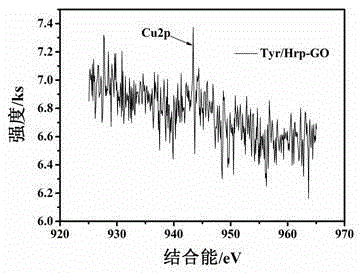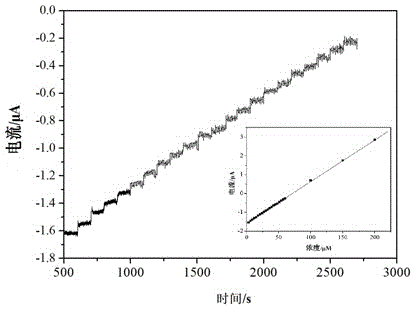Preparation method and application of co-immobilized enzyme electrode for detecting hydroquinone and catechol
A technology for hydroquinone and catechol is applied in the field of preparation of co-immobilized enzyme electrodes for detecting hydroquinone and catechol, which can solve the problems of high detection limit, inability to detect pollutant sensitivity, etc. Low detection limit, high sensitivity and good selectivity
- Summary
- Abstract
- Description
- Claims
- Application Information
AI Technical Summary
Problems solved by technology
Method used
Image
Examples
Embodiment 1
[0043] Preparation of tyrosinase / peroxidase-graphene oxide-chitosan / glassy carbon electrode (Tyr / Hrp-GO-Chit / GCE)
[0044] Activation treatment of GCE: In the electrochemical workstation, Ag / AgCl is used as the reference electrode, the platinum electrode is used as the counter electrode, and GCE is used as the working electrode, and the 0.5M sulfuric acid solution is scanned at a scan rate of 100mV / s at a potential of -1.0-1.0V. Scan 20 laps. The activated electrodes were left to dry at room temperature.
[0045] 10 mg of GO was stirred in 40 mL of concentrated sulfuric acid and nitric acid mixture (3:1) for 1.5 h, put into concentrated hydrochloric acid and sonicated for 1.5 h, filtered and washed with deionized water, and dried at room temperature.
[0046] Dissolve 10 mg of carboxylated GO in 100 mL of SOCl 2 The mixed solution of DMF and DMF (20:1) was stirred in a water bath for 24 hours at a temperature of 70°C. The resulting acid-chlorinated graphene was filtered, wa...
Embodiment 2
[0053] Sensitivity, detection limit and detection range of Tyr / Hrp-GO-Chit / GCE for HQ and CC detection
[0054] Configuration pH is the phosphate buffer solution of 6.5, this solution is under agitation, and the Tyr / Hrp-GO-Chit / GCE that prepares with embodiment 1 is made working electrode, and platinum electrode is made counter electrode, and Ag / AgCl is made reference electrode, The solution was scanned using chronoamperometry.
[0055] image 3 The chronoamperometry graph of the buffer solution in which HQ was continuously added dropwise was scanned by chronoamperometry for the Tyr / Hrp-GO-Chit / GCE electrode (the inset is the fitting curve between the current value and the concentration of HQ (I(HQ)=-0.0222C(HQ )-1.5854)), the operating voltage is -0.13V. According to the graph analysis, the linear range of Tyr / Hrp-GO-Chit / GCE to detect HQ is 3-200μM, and the sensitivity is 22.2μAmM -1 , the limit of detection was 1.26 μM.
[0056] Figure 4 The chronoamperometric diagram...
Embodiment 3
[0058] Preparation of Tyr / Hrp-GO-Chit / GCE
[0059] In the electrochemical workstation, Ag / AgCl was used as the reference electrode, the platinum electrode was used as the counter electrode, and the GCE was used as the working electrode. The 0.1M sulfuric acid solution was scanned at a scan rate of 50mV / s at a potential of -1.0-1.0V for 10 cycles. The activated electrodes were left to dry at room temperature.
[0060] 5 mg of GO was stirred in 20 mL of concentrated sulfuric acid and nitric acid mixture (2:1) for 1 h, put into concentrated hydrochloric acid and sonicated for 1 h, filtered and washed with deionized water, and dried at room temperature.
[0061] Dissolve 5 mg of carboxylated GO in 50 mL of SOCl 2 And the mixed solution of DMF (10:1) was stirred in a water bath for 12h at a temperature of 60°C. The resulting acid-chlorinated graphene was filtered, washed with anhydrous tetrahydrofuran, and vacuum-dried at room temperature.
[0062] 5 mg of acid-chlorinated GO wa...
PUM
| Property | Measurement | Unit |
|---|---|---|
| concentration | aaaaa | aaaaa |
Abstract
Description
Claims
Application Information
 Login to View More
Login to View More - R&D
- Intellectual Property
- Life Sciences
- Materials
- Tech Scout
- Unparalleled Data Quality
- Higher Quality Content
- 60% Fewer Hallucinations
Browse by: Latest US Patents, China's latest patents, Technical Efficacy Thesaurus, Application Domain, Technology Topic, Popular Technical Reports.
© 2025 PatSnap. All rights reserved.Legal|Privacy policy|Modern Slavery Act Transparency Statement|Sitemap|About US| Contact US: help@patsnap.com



